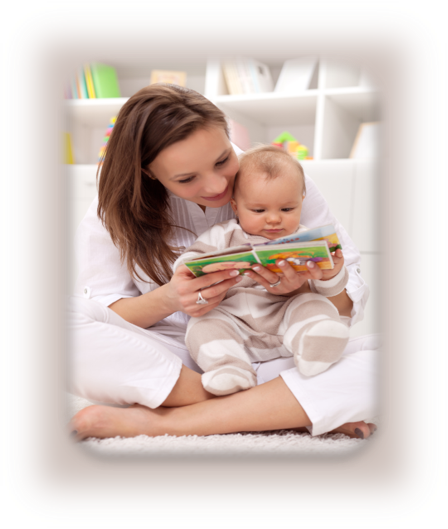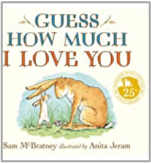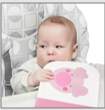Baby in the House
Read Alouds?
Pre-birth to 12 months and BEYOND

March 15, 2024
Once an infant is carried through the door everyone’s life changes. The number one focus is caring for the new bundle of joy. Those first three months offer the family a rocky learning curve. The days and nights turn out to feel like the ups and downs of a roller coaster—up to feed-down to rest, up to feed-down to rest etc.
This was just a dream for the new mother a few days ago and now reality is here. The days are filled with oh-so many challenges and an all important one at the top of her listis the “quest for rest”. It’s true that rest is best in the form of sleep, a needed requirement to keep her strength up and over-all health sound. Easy to say but much harder to do, that is finding those lengthy long deep sleeps. One way to snatch a little rest is to create a Reading Time with the infant. This is a new type of R.& R.— Rest and Read Aloud.
It’s been established by the scientist through in-depth research and studies of young babies that reading to them is important. One recent study by researchers at the Marshall University Joan C. Edwards School of Medicine found that. “Daily reading improved language development in infants 12 months and younger”. Being read to is valuable and starts their language learning journey, leading the way to becoming lifelong readers.
Language development starts in the womb, continues at birth and throughout those critical first three years of a child’s life. One of the ways to kick off language learning is through regular Reading Times. It should be a relaxing time for both the baby and parent. If a new mom is in a panic to check it off their to do list—don’t do it. Just skip it until there is better time to provide that warm comforting experience for the baby. Why? Because the baby can instinctually feel the emotions of the reader.
When it feels right – begin knowing it’s “short and sweet”. One can set a goal of five minutes in length to start. As the baby grows older and their attention span increases the minutes for Reading Time will too. It may seem like a waste of time since the baby cannot understand the printed words read to them.. NO not true, these shared reading experiences are powerful!
Benefits & Helpful Tips
Language Development: Hearing words expressed in a variety of ways supports their language learning. An older baby may start communicating by making babbling sounds while the books are read. Using these beginning language sounds are their first steps in producing speech.
-The voice one uses to interact with the baby is important. “Parentese” is a style that works well when reading books - (read details about “Parentese” in Talking Time posts).
Social/Emotional Development: Book sharing is a way to expand emotional connections. Human touch develops a loving bond needed for their emotional success. A baby thrives on it! This is a social relaxing time and forms a warm partnership through the exchange of facial and vocal expressions.
-Find a comfortable spot and cuddle up together. Holding the baby close will bring fabulous rewards.
Cognitive Development: The baby brain is a learning machine.— ready to go immediately on day one. The brain is growing and developing neuron connections rapidly. Reading to a baby helps to stimulate their curiosity, imagination, and memory. Multiple ideas are being introduced visually and auditorily to the baby. As the baby gets older other aspects of reading are beginning to be absorbed, for example: concepts of print and vocabulary words.
-Point and talk about each of the colorful picture or characters in the book. Sometimes just say the name of the picture after reading the sentence or phrase that is pinted on each page.
FIRST BOOKS There is an abundance of wonderful children’s books available: libraries, stores, internet, garage sales etc. Friends and family members may be able to provide some too. Below are some examples of baby book types that are different from the regular paper filled books. These types do have advantages, but regular paper paged children’s books are recommended as well.
Examples of types of baby books:--which are not regular paper paged books.
cloth book

touch & feel book

board book

Many of these kind of books are washable or wipeable for a longer shelf life. Some contain textured items to feel or interactive pages to involve the baby with the book.
BOOK INVESTAGATORS are present AND ready to engage….
- Babies may sample the book flavor by putting edges in mouth. (the taste test)
- Babies may tear paper pages. (Oops!)
- Babies may nibble or even eat pieces of pages. (Oh, no! -Yum?)
- Babies may drop or toss books. (the gravity test—or the pick it up game)
All of these behaviors are possible and likely to occur during Reading Time. It’s natural for a baby to investigate this exciting thing—the book-- that is being shared with them. Lovingly help them learn “how a book works”. Sharing the book together should be a positive experience for all— relax and enjoy it!

As the months pass the shared book experience will offer up more baby behaviors. These actions help to teach the reader patience! Babies have a want to turn pages—just like mom BUT faster or from back to front Or to hold the book just like dad BUT upside down. Remember they are trying out what’s been shown, just not exactly the perfect way yet. They understand words are said when holding a book BUT not the idea that those squiggly black things tell one what to say. No, worries it’s a process and a progression of skills.
Reading Time is an important way to bond with ones’ baby through the closeness of each shared experience. Enjoy these moments for time does speed by ever so fast!
Happy Days to you
Kylene

“When I say to a parent, “read to a child”, I don’t want it to sound like medicine. I want it to sound like chocolate. ”
Mem Fox, children’s book author



